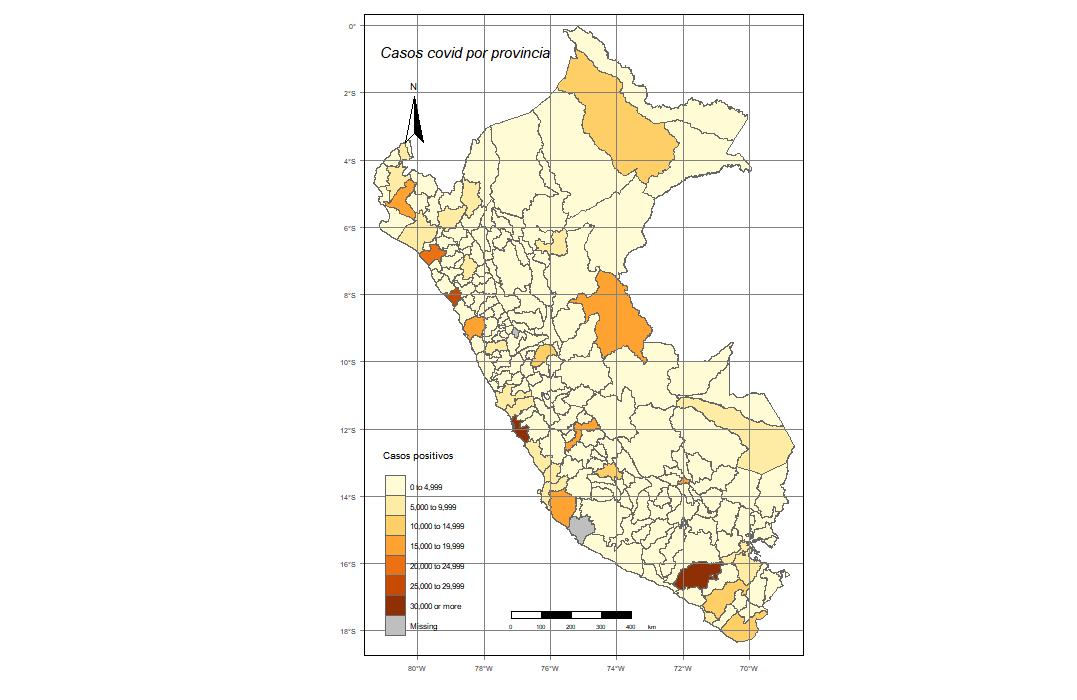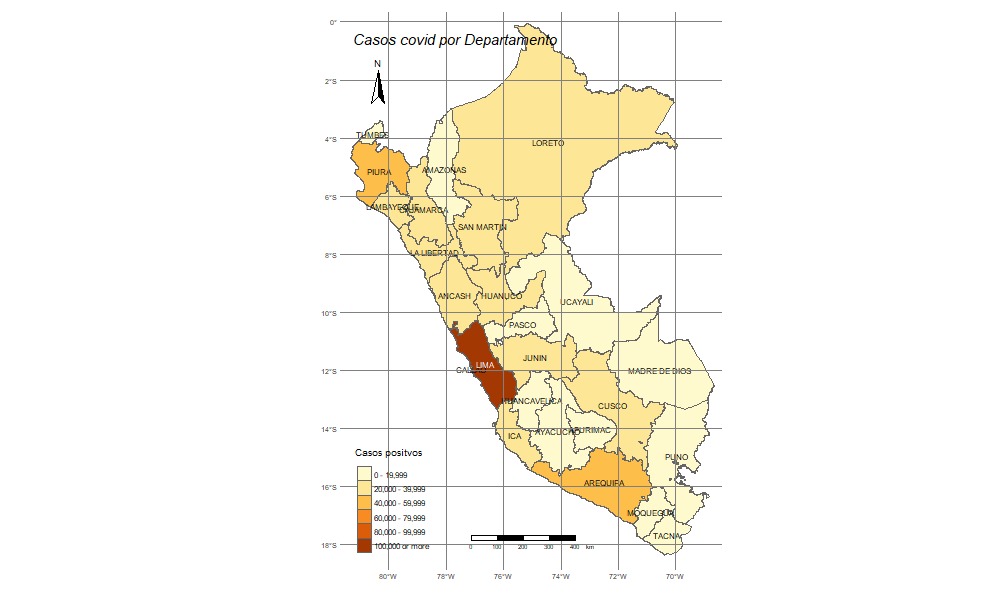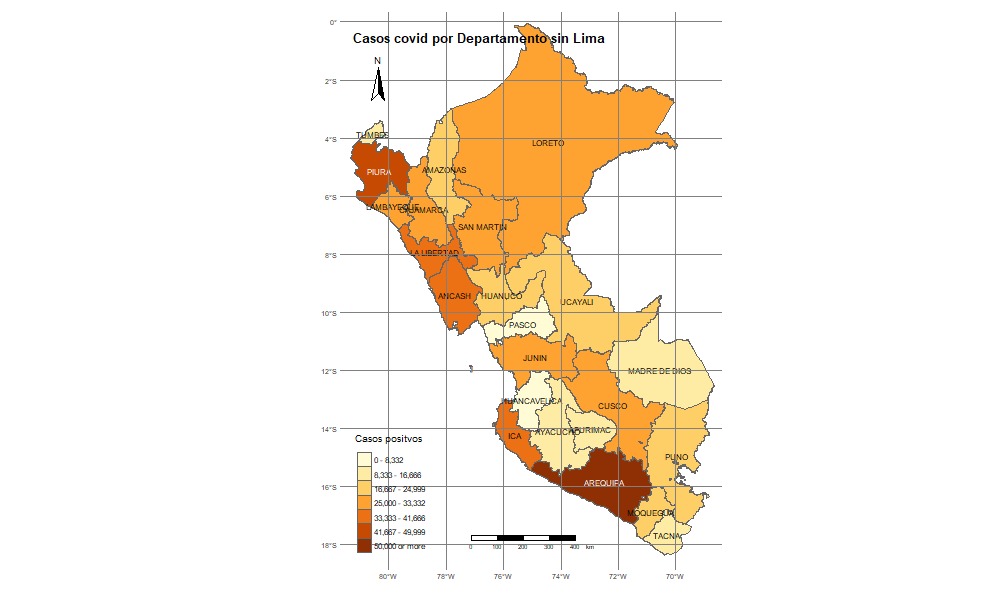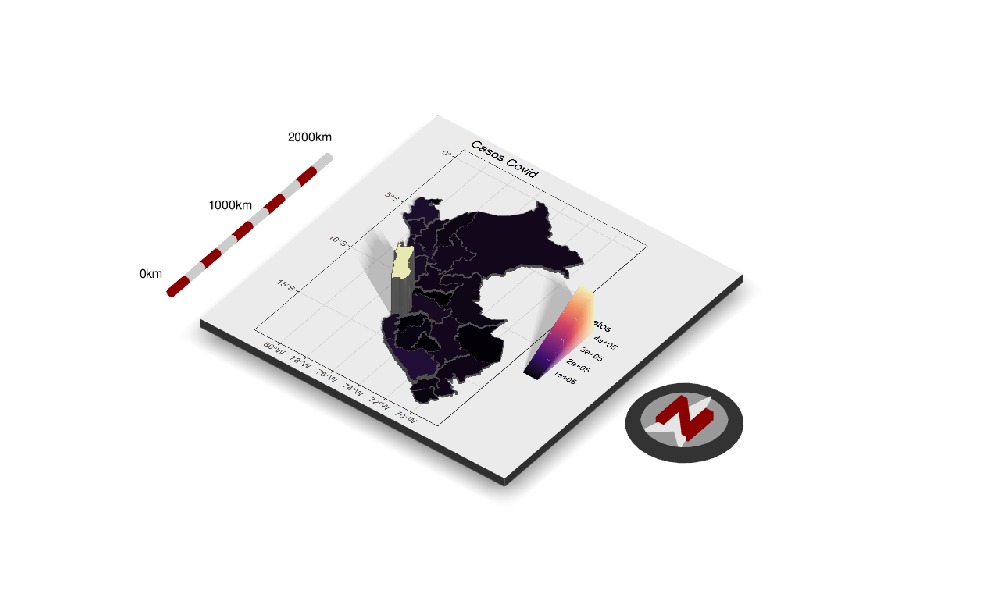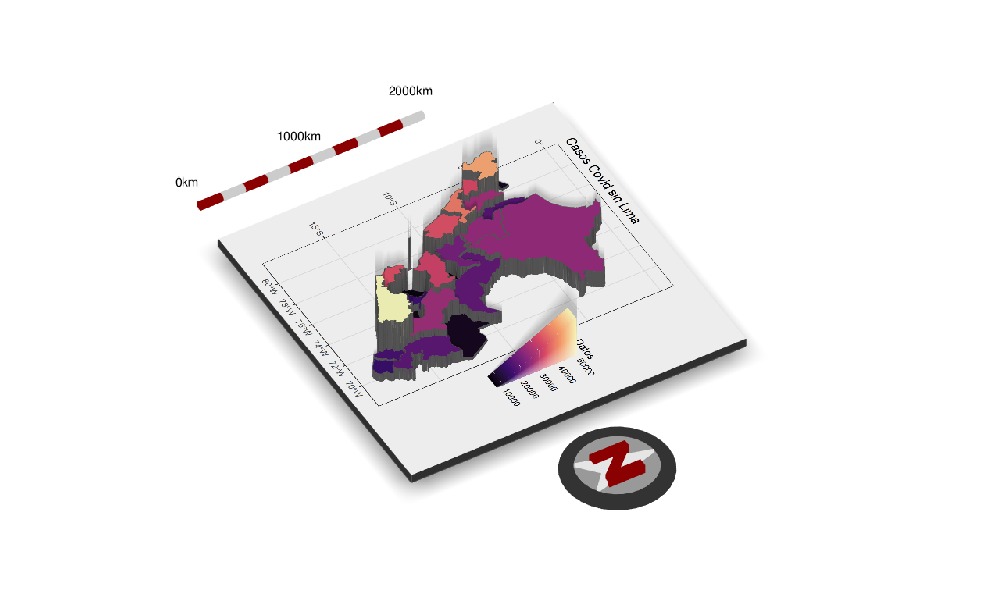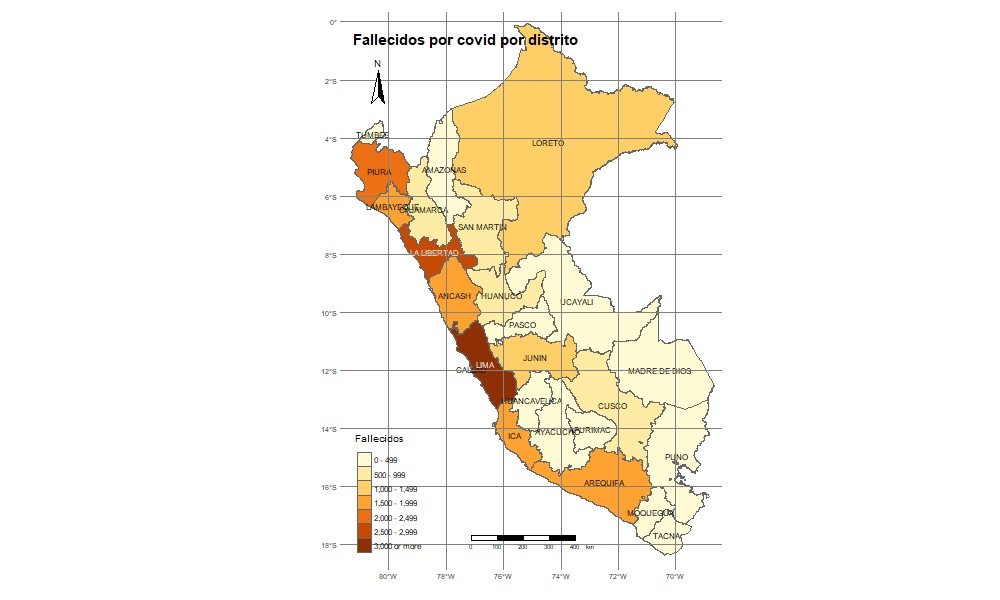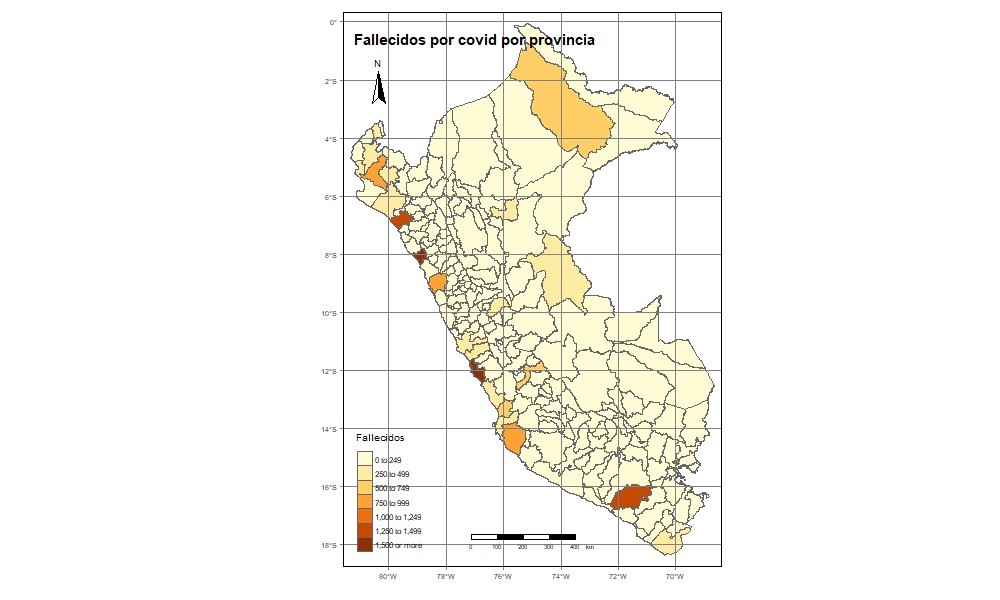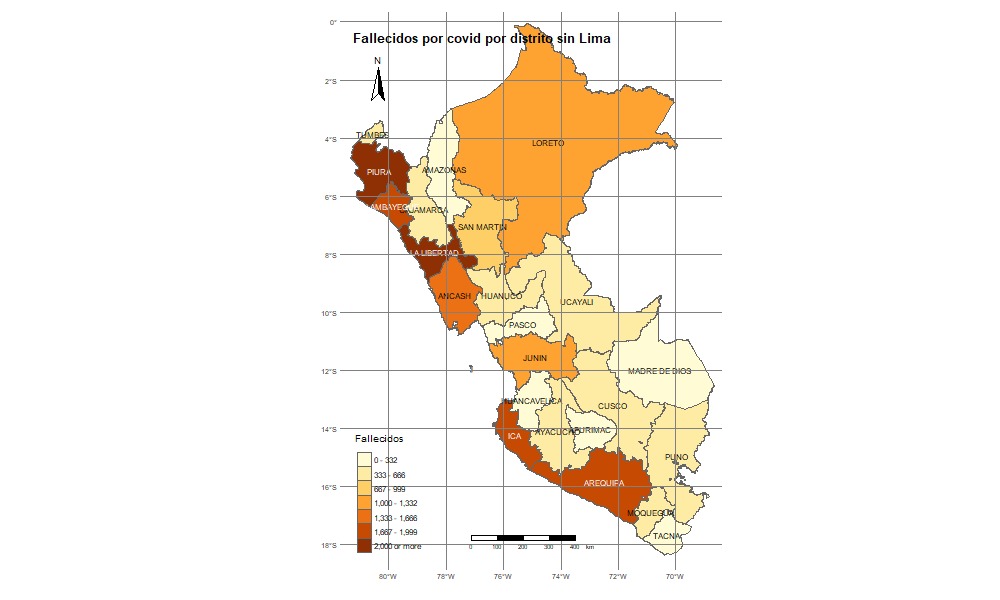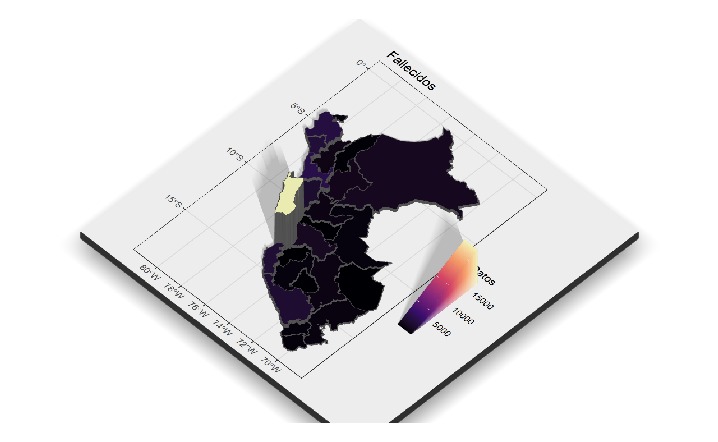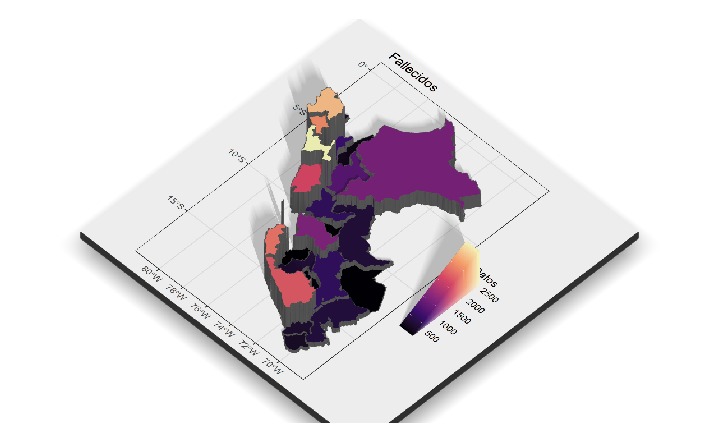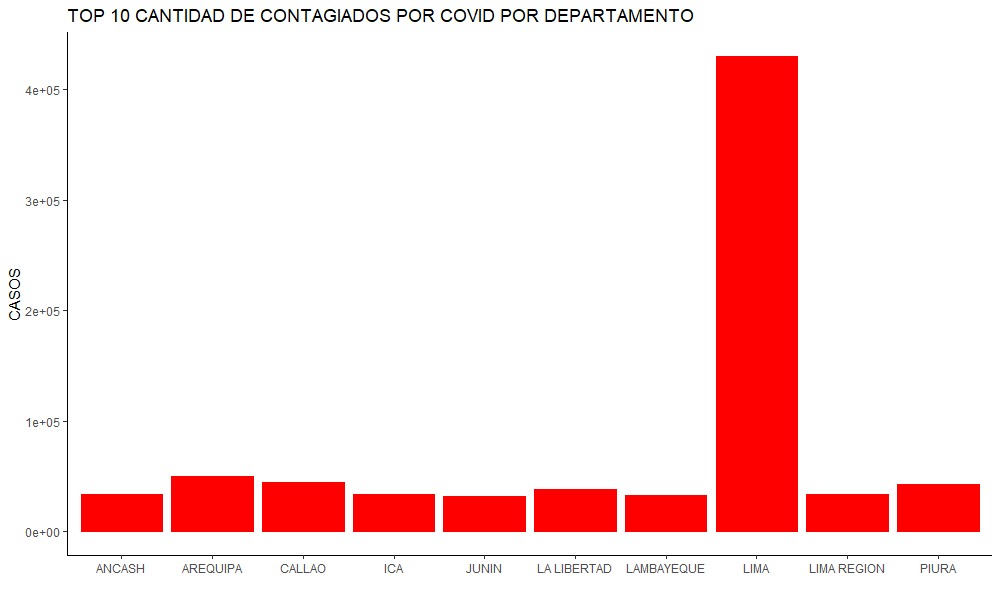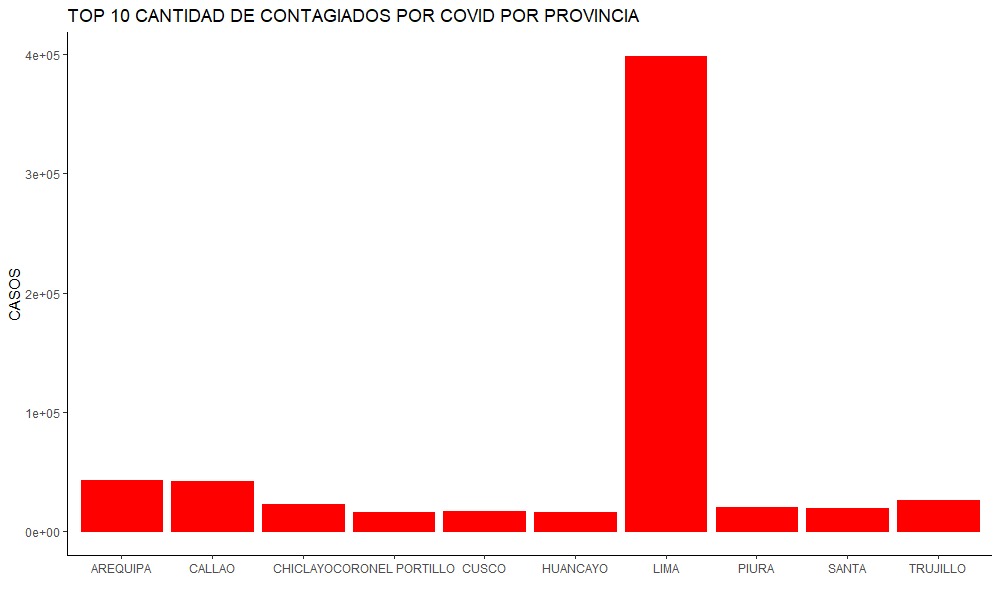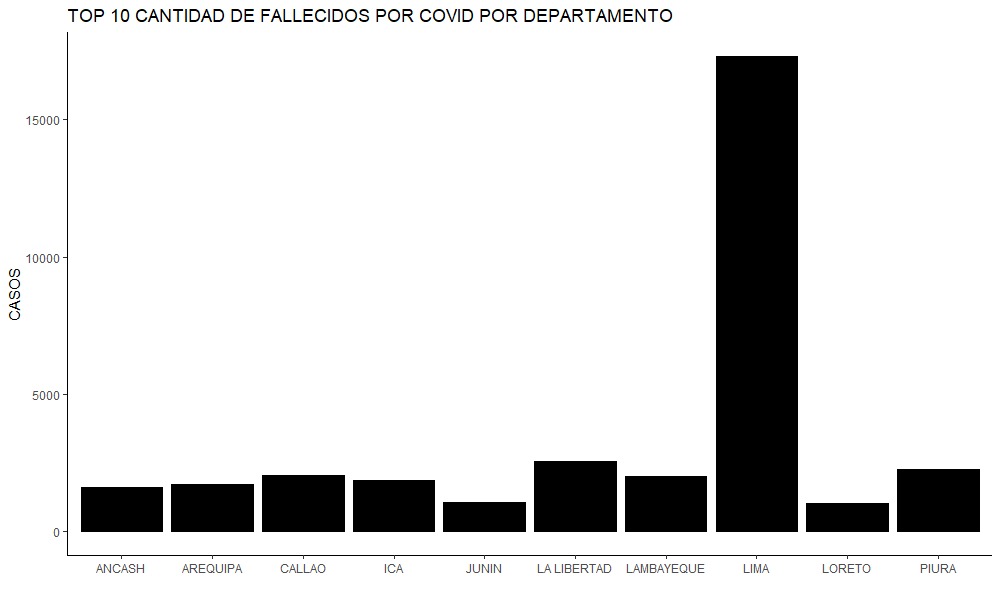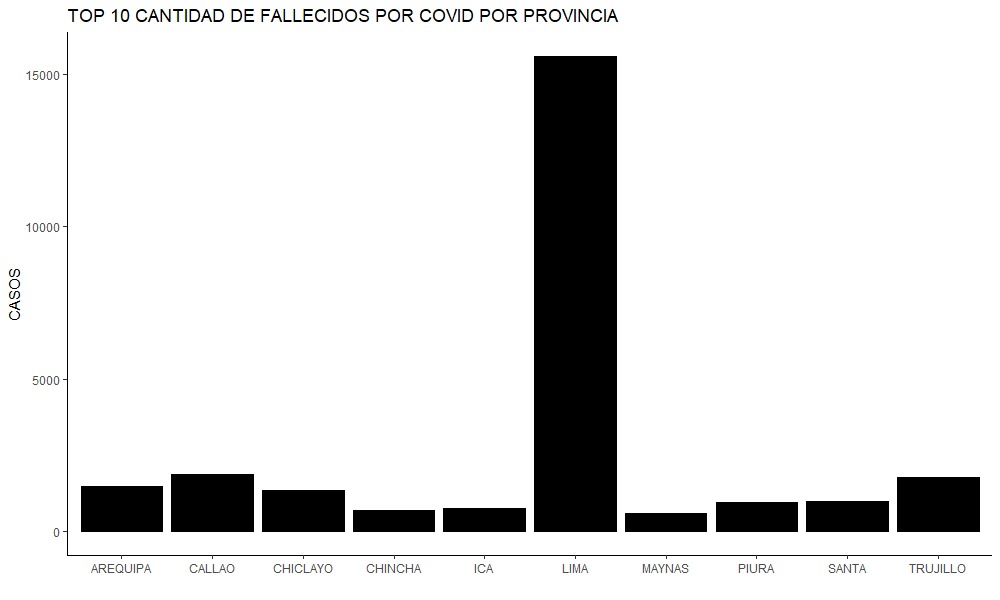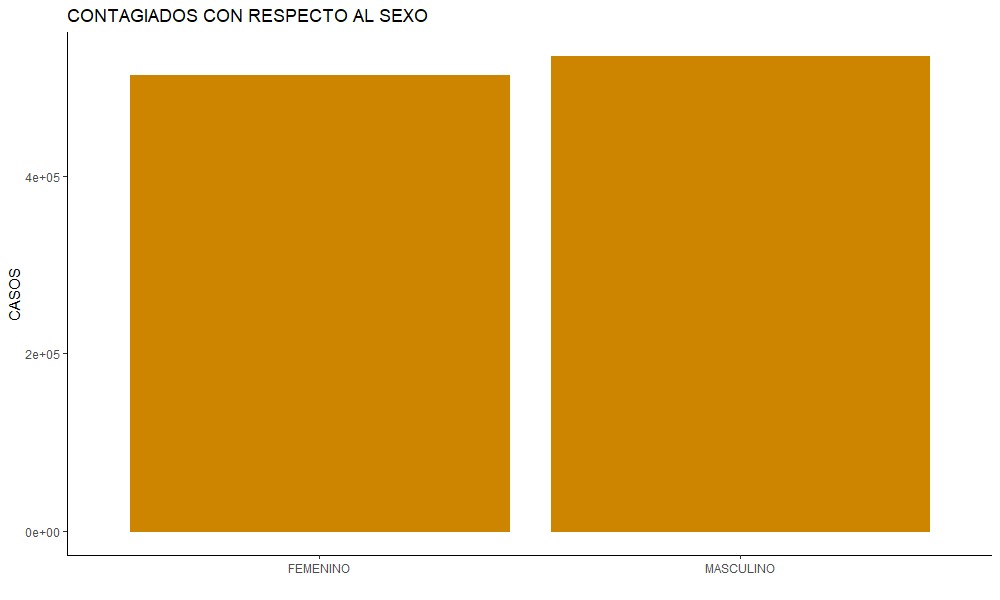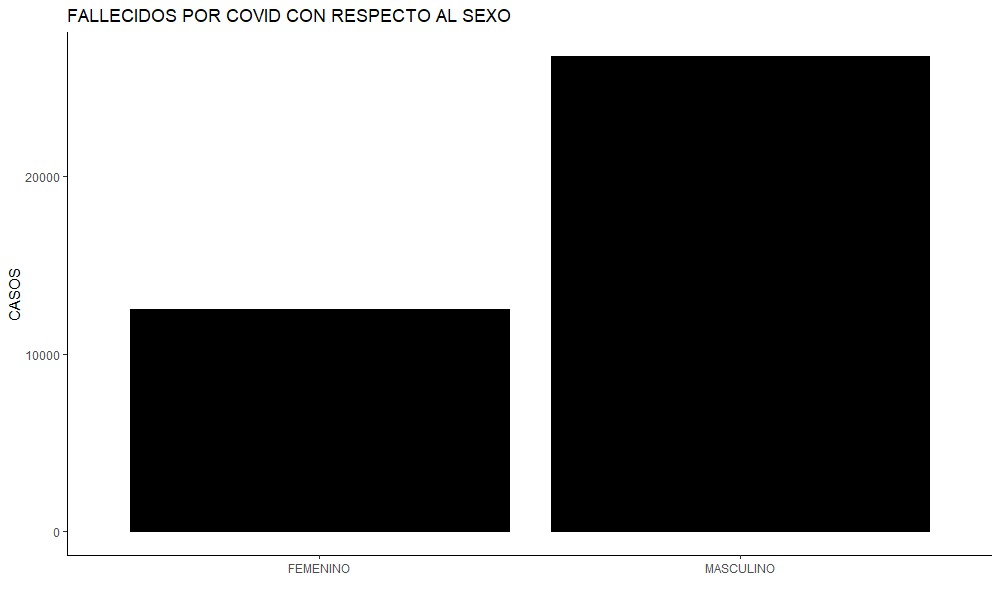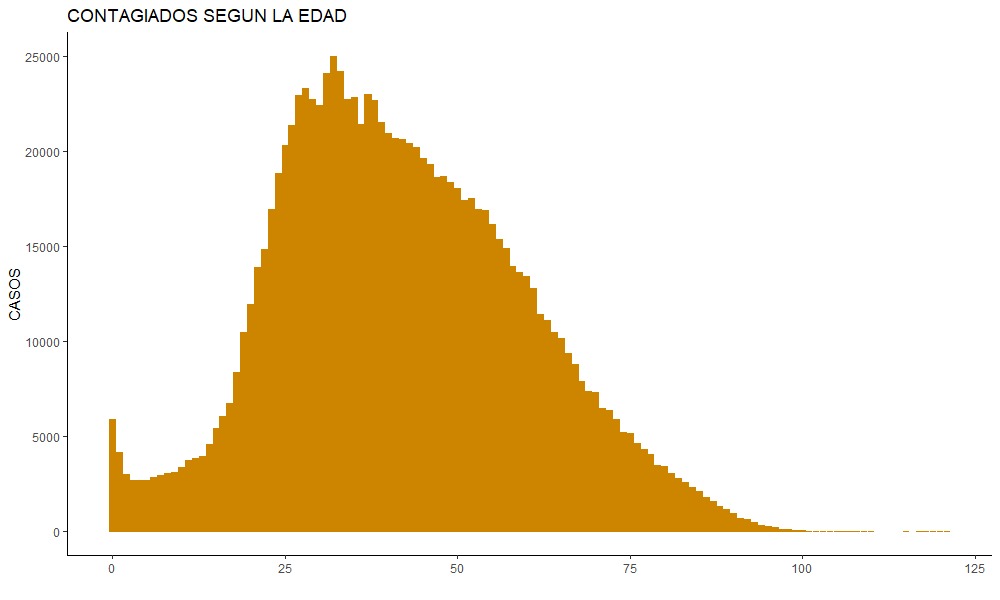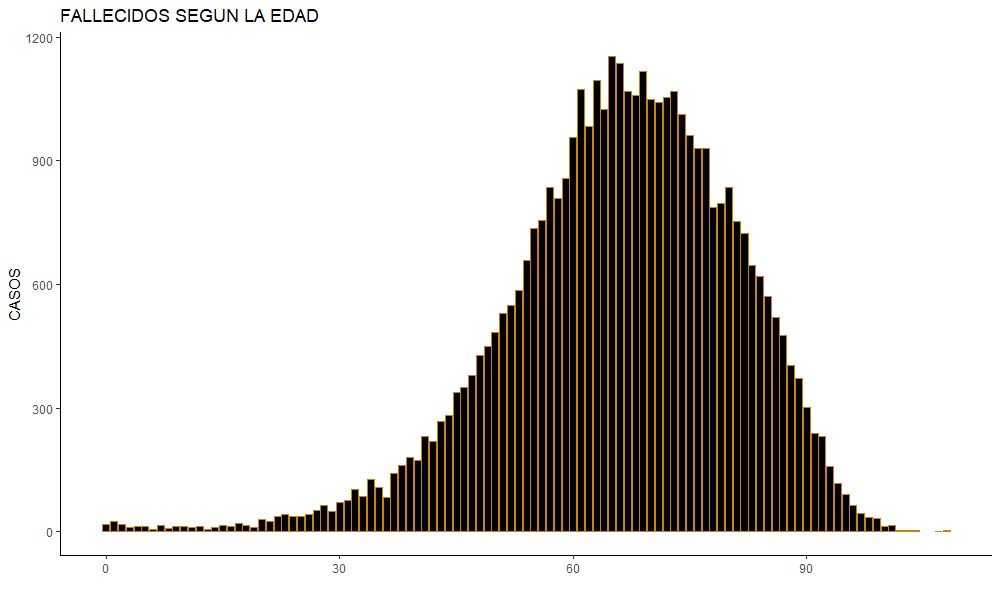Elaborado por Barzola Bustamante José Mathias,Ccanto Vargas Eduardo Ivan, Cuenca Cajusol Nicole Allison y Angie Sylvana Flores Gutierrez, 5 de febrero del 2021
En este proyecto analizaremos los datos del COVID en el Perú para luego con ayuda de la libreria ggplot2 extraer los mapas de casos postivos y fallecidos por COVID en el Perú.
-library(rgdal)
-library(rgeos)
-library(dplyr)
-library(tmap)
-library(leaflet)
-biblioteca (ggplot2)
-library(sp)
-library(viridisLite)
-library(viridis)
-library(tidyverse)
-library(sf)
-library(rayshader)
¡ No olvidarte setear tu directorio de trabajo!
Descargar los datos shapefile de algún geoservidor oficial. Como este: https://www.geogpsperu.com/
1. Cargamos la librería donde tenemos guardado nuestro shp. y csv. para este caso, que es PROVINCIAS
setwd("C:/Users/NICOLE/Desktop/PROGRA")
mapa <- readOGR("C:/Users/NICOLE/Desktop/PROGRA/PROVINCIAS.shp")
datacovid <- read.csv2("C:/Users/NICOLE/Desktop/PROGRA/positivos_covid.csv
head(mapa)
names(mapa)[2]="DEPARTAMENTO"
covid <- datacovid %>% group_by(PROVINCIA) %>% summarise(Frequency=n())
head(mapa)
head(datacovid)
covid_mapa1 <- merge(mapa,covid,by="PROVINCIA")
plot(covid_mapa1)
qtm(covid_mapa1,fill = "Frequency",col="col_blind")
qtm(covid_mapa1,fill=c("Frequency"),
col = "Median_income",
title="Casos covid por provincia",
palette = " BuGn" ,
scale = 0.7 ,
fill.title="Casos positivos",
title.font=1,
sill.style ="fixed",
title.fontface=3,
fill.breaks=round(c(seq(0,30000,length.out = 7),Inf),),0)
+ tm_scale_bar(position = c("center","bottom"))+
tm_graticules()+
tm_compass(position = c("left","top")) + tm_borders()
5. Cargamos la librería donde tenemos guardado nuestro shp. y csv. para este caso, que es DEPARTAMENTOS
mapa <- st_read("C:/Users/NICOLE/Desktop/PROGRA/DEPARTAMENTOS.shp")
head(mapa)
names(mapa)[2]="DEPARTAMENTO"
covid2 <- datacovid %>% group_by(DEPARTAMENTO) %>% summarise(Frequency=n())
covid_mapa2 <- merge(mapa,covid2,by="DEPARTAMENTO")
qtm(covid_mapa2,fill = "Frequency",col="col_blind")
qtm(covid_mapa2,fill=c("Frequency"),
col = "Median_income",
title="Casos covid por Departamento",
palette = " BuGn" ,
scale = 0.7 ,
fill.title="Casos positvos",
title.font=1,
sill.style ="fixed",
title.fontface=3,
fill.breaks=round(c(seq(0,100000,length.out = 6),Inf)),0)+
tm_text("DEPARTAMENTO", size = 0.7)+
tm_layout(legend.format = list(text.separator = "-"),frame = F, asp=NA)+
tm_legend(legend.position = c("left", "bottom"))+
tm_scale_bar(position = c("center","bottom"))+
tm_graticules()+
tm_compass(position = c("left","top"))
View(covid2)
covid3 <- covid2[c(-15,-16),]
View(covid3)
mapa2 <- mapa[-15,]
covid_mapa3 <- merge(mapa2,covid3,by="DEPARTAMENTO)
qtm(covid_mapa3,fill = "Frequency",col="col_blind")
qtm(covid_mapa3,
fill=c("Frequency"),
col = "Median_income",
title="Casos covid por Departamento sin Lima",
palette = " BuGn" ,
scale = 0.7 ,
fill.title="Casos positvos",
title.font=1,
sill.style ="fixed",
title.fontface=2,
fill.breaks=round(c(seq(0,50000,length.out = 7),Inf)),0)+
tm_text("DEPARTAMENTO", size = 0.7)+
tm_layout(legend.format = list(text.separator = "-"),frame = F, asp=NA)+
tm_legend(legend.position = c("left", "bottom"))+
tm_scale_bar(position = c("center","bottom"))+
tm_graticules()+
tm_compass(position = c("left","top"))
Cargamos y llamamos a las siguientes librerias
library(viridisLite)
library(viridis)
library(tidyverse)
library(sf)
install.packages("rayshader")
library(rayshader)
install.packages("magick")
library(magick)
install.packages("av")
library(av)
library(dplyr)
install.packages("rayrender")
library(rayrender)
covid_mapa2 <- mutate(covid_mapa2,Datos =Frequency)
ggcovid <- ggplot(data = covid_mapa2) +
geom_sf(aes(fill = Datos)) +
scale_fill_viridis_c(option = "A")+
ggtitle("Casos Covid") +
theme_bw()
plot_gg(ggcovid,
multicore = T,
width = 5 ,
height = 5,
scale = 200,
windowsize = c(1280,720),
zoom = 0.60 ,
phi = 50 ,
sunangle = 120,
theta=45)
render_camera(fov = 0, theta = 60, zoom = 0.75, phi = 45)
render_scalebar(limits=c(0, 1000, 2000),
label_unit = "km",
position = "W",
y=50,
scale_length = c(0.33,1))
render_compass(position = "E")
render_snapshot(clear=TRUE)
covid3 <- covid2[c(-15,-16),]
mapa2 <- mapa[-15,]
covid_mapa3 <- merge(mapa2,covid3,by="DEPARTAMENTO")
covid_mapa3 <- mutate(covid_mapa3,Datos =Frequency)
ggcovid <- ggplot(data = covid_mapa3) +
geom_sf(aes(fill = Datos)) +
scale_fill_viridis_c(option = "A")+
ggtitle("Casos Covid sin Lima") +
theme_bw()
plot_gg(ggcovid,
multicore = T,
width = 5 ,
height = 5,
scale = 200,
windowsize = c(1280,720)
,zoom = 0.60 ,
phi = 50 ,
sunangle = 120,
theta=45)
render_camera(fov = 0, theta = 60, zoom = 0.75, phi = 45)
render_scalebar(limits=c(0, 1000, 2000),label_unit = "km",position = "W", y=50,
scale_length = c(0.33,1))
render_compass(position = "E")
render_snapshot(clear=TRUE)
fallecidos <-read.csv2("C:/Users/NICOLE/Desktop/PROGRA/fallecidos_covid.csv")
fallecidos_covid <- fallecidos %>%
group_by(DEPARTAMENTO) %>%
summarise(Frequency=n())
fallecidos_mapa <- merge(mapa,fallecidos_covid,by="DEPARTAMENTO")
qtm(fallecidos_mapa,fill = "Frequency",col="col_blind")
qtm(fallecidos_mapa,fill=c("Frequency"),col = "Median_income",
title="Fallecidos por covid por distrito",palette = " BuGn" ,
scale = 0.7 , fill.title="Fallecidos",
title.font=1,sill.style ="fixed",title.fontface=2,
fill.breaks=round(c(seq(0,3000,length.out = 7),Inf)),0)+
tm_text("DEPARTAMENTO", size = 0.7)+
tm_layout(legend.format = list(text.separator = "-"),frame = F, asp=NA)+
tm_legend(legend.position = c("left", "bottom"))
fallecidos_covid2 <- fallecidos %>%
group_by(PROVINCIA) %>%
summarise(Frequency=n())
fallecidos_mapa2 <- merge(mapa,
fallecidos_covid2,
by="PROVINCIA")
names(mapa)
qtm(fallecidos_mapa2,fill = "Frequency",col="col_blind")
qtm(fallecidos_mapa2,fill=c("Frequency"),col =
"Median_income",title=
"Fallecidos por covid por provincia",
palette = " BuGn" , scale =
0.7 , fill.title="Fallecidos",
title.font=1,sill.style =
"fixed",title.fontface=2,
fill.breaks=round(c(seq(0,1500,
length.out = 7),Inf)),0)
fallecidos_covid3 <- fallecidos_covid[c(-15),]
fallecidos_mapa3 <- merge(mapa2,fallecidos_covid3,by="DEPARTAMENTO")
qtm(fallecidos_mapa3,fill = "Frequency",col="col_blind")
qtm(fallecidos_mapa3,fill=c("Frequency"),
col = "Median_income",
title="Fallecidos por covid por distrito sin Lima",
palette = " BuGn" , scale = 0.7 , fill.title="Fallecidos",
title.font=1,sill.style =
"fixed",title.fontface=2,
fill.breaks=round(c(seq(0,2000,
length.out = 7),Inf)),0)+
tm_text("DEPARTAMENTO", size = 0.7)+
tm_layout(legend.format = list(text.separator = "-"),
frame = F, asp=NA)+
tm_legend(legend.position = c("left", "bottom"))
No olvidar llamar a las siguientes librerias
library(viridisLite)
library(viridis)
library(tidyverse)
library(sf)
library(rayshader)
library(magick)
library(av)
fallecidos_mapa <- mutate(fallecidos_mapa,Datos =Frequency)
ggfallecidos <- ggplot(data = fallecidos_mapa) +
geom_sf(aes(fill = Datos)) + scale_fill_viridis_c(option = "A")+ ggtitle("Fallecidos") +
theme_bw()
plot_gg(ggcovid,multicore = T,width = 5 , height = 5, scale = 200, windowsize = c(1280,720)
,zoom = 0.60 ,phi = 50 ,sunangle = 120,theta=45)
render_camera(fov = 0, theta = 60, zoom = 0.75, phi = 45)
render_scalebar(limits=c(0, 1000, 2000),label_unit = "km",position = "W", y=50,
scale_length = c(0.33,1))
render_compass(position = "E")
render_snapshot(clear=TRUE)
fallecidos_mapa3 <- mutate(fallecidos_mapa3,Datos =Frequency)
ggfallecidos2 <- ggplot(data = fallecidos_mapa3) +
geom_sf(aes(fill = Datos)) + scale_fill_viridis_c(option = "A")+ ggtitle("Fallecidos sin contar Lima") +
theme_bw()
plot_gg(ggcovid,multicore = T,width = 5 , height = 5, scale = 200, windowsize = c(1280,720)
,zoom = 0.60 ,phi = 50 ,sunangle = 120,theta=45)
render_camera(fov = 0, theta = 60, zoom = 0.75, phi = 45)
render_scalebar(limits=c(0, 1000, 2000),label_unit = "km",position = "W", y=50,
scale_length = c(0.33,1))
render_compass(position = "E")
render_snapshot(clear=TRUE)
Llamamos a las siguientes librerias
library(ggplot2)
library(dplyr)
library(ggplot)
top_10 <- covid2 %>%
top_n(wt = Frequency,n=10)%>%
arrange(desc(Frequency))
top_10[top_10$Frequency]
g_top10 <- ggplot(top_10,
aes(x= DEPARTAMENTO,y= Frequency))+
geom_col(fill="Red",col = "Red")+
ggtitle("TOP 10 CANTIDAD DE CONTAGIADOS POR COVID POR DEPARTAMENTO")+
xlab("")+
ylab("CASOS") +
theme_classic()
covid3<- covid[-72,]
top_10pro<- covid3 %>%
top_n(wt = Frequency,n=10)%>%
arrange(desc(Frequency))
g_top10pro <- ggplot(top_10pro,
aes(x= PROVINCIA,y= Frequency))+
geom_col(fill="Red",col = "Red")+
ggtitle("TOP 10 CANTIDAD DE CONTAGIADOS POR COVID POR PROVINCIA ")+
xlab("")+
ylab("CASOS") +
theme_classic()
Llamamos a las siguientes librerías library(ggplot2) library(dplyr)
top_10falle <- fallecidos_covid%>%
top_n(wt = Frequency,n=10)%>%
arrange(desc(Frequency))
g_top10falle <- ggplot(top_10falle,
aes(x= DEPARTAMENTO,y= Frequency))+
geom_col(fill="Black",col = "Black")+
ggtitle("TOP 10 CANTIDAD DE FALLECIDOS POR COVID POR DEPARTAMENTO")+
xlab("")+
ylab("CASOS")+
theme_classic()
top_10falle2 <- fallecidos_covid2%>%
top_n(wt = Frequency,n=10)%>%
arrange(desc(Frequency))
g_top10falle2 <- ggplot(top_10falle2,
aes(x= PROVINCIA,y= Frequency))+
geom_col(fill="Black",col = "Black")+
ggtitle("TOP 10 CANTIDAD DE FALLECIDOS POR COVID POR PROVINCIA")+
xlab("")+
ylab("CASOS") +
theme_classic()
covidsex <- datacovid %>%
group_by(SEXO) %>% summarise(Frequency=n())
g_sex <- ggplot(covidsex,
aes(x=SEXO,y=Frequency))+
geom_col(fill="ORANGE3",col = "ORANGE3")+
ggtitle("CONTAGIADOS CON RESPECTO AL SEXO")+
xlab("")+
ylab("CASOS") +
theme_classic()
covidfallesex <- fallecidos%>%
group_by(SEXO) %>%
summarise(Frequency=n())
covidfallesex2<- covidfallesex[c(-1,-2),]
g_sexfalle <- ggplot(covidfallesex2,
aes(x=SEXO,y=Frequency))+
geom_col(fill="black",col = "black")+
ggtitle("FALLECIDOS POR COVID CON RESPECTO AL SEXO")+
xlab("")+
ylab("CASOS") +
theme_classic()
covidage<- datacovid %>%
group_by(EDAD) %>%
summarise(Frequency=n())
g_age <- ggplot(covidage,
aes(x=EDAD,y=Frequency))+
geom_col(fill="ORANGE3",col = "ORANGE3")+
ggtitle("CONTAGIADOS CON RESPECTO A LA EDAD")+
xlab("")+
ylab("CASOS")+
theme_classic()
covidagedead<- fallecidos %>%
group_by(EDAD_DECLARADA) %>%
summarise(Frequency=n())
g_agedead <- ggplot(covidagedead,
aes(x=EDAD_DECLARADA,y=Frequency))+
geom_col(fill="ORANGE3",col = "ORANGE3")+
ggtitle("CONTAGIADOS CON RESPECTO A LA EDAD")+
xlab("")+
ylab("CASOS")+
theme_classic()
R studio y Git
Barzola Bustamente Jose Mathias - Análisis de casos positivos por Covid en el Perú en 2D
Ccanto Vargas Eduardo Ivan - Análisis de casos positvos por Covid en el Perú en 3D
Cuenca Cajusol Nicole Allison - Análisis de los fallecidos por Covid en el Perú
Flores Gutiérrez Angie Sylvana - Ploteo de fallecidos por Covid en el Perú
Agradecemos al docente Roy Yali Samaniego por su apoyo en este trabajo.
